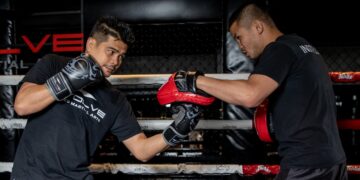
Brazilian Jiu-Jitsu is a martial art that thrives on both offensive and defensive techniques. The turtle is considered as one of the premier positions in the art and is known as a tough position to crack in the hands of a master. While it may seem like a purely defensive posture at first glance, the turtle position can be a gateway to numerous offensive and counter-offensive opportunities. Today, we will go over the defensive fortress that is the turtle, and one of the unique submissions you can do from the position – the turtleplata.
Understanding The Turtle Position
The turtle position in BJJ is often seen as a defensive posture, where a practitioner tucks their knees under their body and brings their elbows close to their knees while their hands protect their neck and head. The practitioner’s back is typically facing the opponent, which makes it appear vulnerable. However, when used effectively, the turtle position can be a strategic position that allows for quick transitions, counters, and submissions.
The turtle position is commonly assumed when a practitioner is defending against a guard pass or after being swept, and they want to prevent their opponent from taking the back or securing a dominant position like side control or mount. While it’s true that the turtle position can expose a grappler to back takes, chokes, and other attacks, it also offers unique opportunities to counter and escape, making it a versatile position in the hands of an experienced practitioner.
Versatility Of The Turtle
The turtle position, when mastered, can be a strong defensive option. Like a fortress, it allows a practitioner to stay protected while keeping their opponent at bay. Also, the compact nature of the turtle makes it difficult for an opponent to establish control or set up submissions without creating openings for the bottom player to escape.
From a defensive standpoint, the turtle position can help you avoid giving up points in competition by preventing your opponent from securing a dominant position. By staying mobile and keeping your elbows and knees tight, you can frustrate your opponent’s attempts to pass or submit you, forcing them to expend energy while you wait for an opportunity to counter or escape.
Offensively, the turtle position can serve as an avenue for various attacks. Skilled practitioners use the turtle to bait their opponents into overcommitting or exposing themselves to counterattacks. One of the most intriguing offensive techniques that can be executed from the turtle position is the turtleplata. This submission is a variation of the omoplata, but it is initiated from the turtle, making it a surprising and effective attack.
The Turtleplata: A Unique Submission
The turtleplata is a submission that combines elements of the omoplata and the turtle position. The omoplata is a shoulder lock typically applied from the guard, where the practitioner uses their legs to isolate and torque the opponent’s shoulder joint. The turtleplata adapts this concept to the turtle position, allowing the practitioner to submit their opponent even when they appear to be in a disadvantageous spot.
To execute the turtleplata, the practitioner in the turtle position must first identify an opportunity to trap one of their opponent’s arms. This is often possible when the opponent is trying to establish grips, control the hips, or initiate a back take. Once the arm is isolated, the practitioner rolls under or around the opponent while hooking the trapped arm with their leg, similar to setting up an omoplata from the guard.
As the practitioner rolls, they use their body weight to force the opponent’s shoulder towards the mat, applying pressure on the joint and forcing the tap.
Setting Up The Turtleplata
The turtleplata can be a highly effective submission, but it requires precise timing and control to execute properly. The key to setting up the turtleplata lies in baiting your opponent into making a mistake or overcommitting to an attack while you’re in the turtle position.
One common setup for the turtleplata occurs when the opponent attempts to take the back by reaching across to grab your far-side collar or underhook your arm. As they do this, you can trap their arm by securing it with your leg. This involves threading your leg over their arm while maintaining a tight posture in the turtle position. Once the arm is trapped, you can initiate the roll, using your hips and legs to torque the opponent’s shoulder.
Another effective setup is when your opponent tries to control your hips or flatten you out from the turtle position. By shifting your weight and creating a small amount of space, you can sneak your leg into position to trap their arm. From there, you can roll and apply the submission.
The secret to a successful turtleplata is to use unpredictability. Most opponents do not expect a submission attempt from someone in the turtle position, which gives you the element of surprise. This surprise factor often leads to hesitation or a delayed reaction from the opponent, giving you the upper hand in securing the submission.
Integrating The Turtleplata Onto Your Game
The turtleplata is a versatile submission that can be a valuable addition to your BJJ arsenal. If you want to add the turtleplate to your game, practice it in isolated drills and live sparring. Start by drilling the basic mechanics of the turtleplata, focusing on the setup, the roll, and the finish. Once you feel comfortable with the technique, incorporate it into your sparring sessions.
It’s also essential to develop your overall turtle position game. The more comfortable you are in the turtle position, the easier it will be to recognize and capitalize on opportunities to execute the turtleplata. Work on your ability to stay safe in the turtle position, and slowly add weapons to round out the position.
Finally, consider combining the turtleplata with other submissions and escapes from the turtle position. By having multiple options at your disposal, you can keep your opponent guessing and increase your chances of successfully executing the turtleplata or transitioning to another attack.
Conclusion
The turtle position in BJJ is often misunderstood as purely defensive, but it can be an excellent entry to various offensive techniques. By mastering this position, you can turn a seemingly weak position into a powerful tool to submit even the biggest and strongest opponent.
You may also like:
5 Ideas To Modernize Your BJJ Game
The world of Brazilian Jiu-Jitsu is filled with many unique techniques and positions. One of the things that set BJJ apart from other grappling arts is the fact that Jiu-Jitsu allows more freedom to fight…
Starting Brazilian Jiu-Jitsu can be both exciting and overwhelming. With so many techniques, positions, and submissions to learn, it’s easy to feel lost or forget what you’ve practiced during class. However, remembering techniques doesn’t have…
Canada is home to great fighters and martial artists like Rory Macdonald, Carlos Newton, and Georges St-Pierre. Over the past couple of years, Canada has been slowly climbing its way to the top of the…
Over the years, America has become a powerhouse of grappling. Brazilian Jiu-Jitsu stars like Mikey Musumeci, brothers Tye and Kade Ruotolo, Dorian Olivarez, Helena Crevar, and Cole Abate are all proud competitors representing the USA….
Every sport operates in cycles. Every timeline has its end and beginning. As a new dawn starts, a superstar is always born to take the lead toward the quest for greatness. Gordon Ryan is currently…
Brazilian Jiu-Jitsu has evolved significantly over the past few years, with new techniques and strategies becoming popular as grapplers continue to push the boundaries of the art. To stay competitive in this ever-changing landscape, modernizing…
Signing up for martial arts like Muay Thai, Brazilian Jiu-Jitsu (BJJ), and Boxing helps you to lose weight in more ways than one. Engaging in intense exercise, such as martial arts training, provides a significant…
In Singapore’s ever-busy and fast-paced urban landscape, sleep often feels like a luxury rather than a necessity. While much of the city’s energy is fueled by ambition and productivity, sleep deprivation has quietly become an…
Fans of ONE Championship’s Friday Fights at Lumpinee Stadium will be familiar with the name Nabil Anane. Standing at 192 cm, the Thai-Algerian is not only one of the tallest fighters in the ONE arena…
The front snap kick has been used in mixed martial arts (MMA) since its early days. Royce Gracie often peppered opponents with it to set on his takedowns on this way to winning three of…
In Muay Thai, laying traps can be risky business. Even with all the right skill, technique, and planning, they are still a gamble; can you subversively impose your will on your opponent? Will you be…
Jake Paul continues to stir the pot in boxing coming off his recent controversial win against Mike Tyson. Some argue that the fight was fixed, while others complain about not getting their money’s worth. There’s…



































